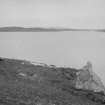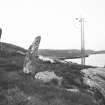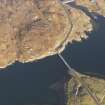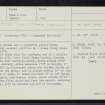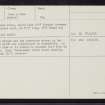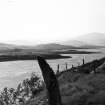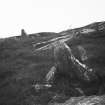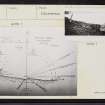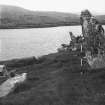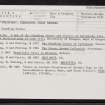Great Bernera, 'tursachan', Barraglom
Standing Stone(S) (Prehistoric)
Site Name Great Bernera, 'tursachan', Barraglom
Classification Standing Stone(S) (Prehistoric)
Alternative Name(s) Bernera Bridge
Canmore ID 4112
Site Number NB13SE 2
NGR NB 1642 3424
Datum OSGB36 - NGR
Permalink http://canmore.org.uk/site/4112
- Council Western Isles
- Parish Uig
- Former Region Western Isles Islands Area
- Former District Western Isles
- Former County Ross And Cromarty
NB13SE 2 1642 3424.
(NB 1642 3424) Tursachan (NR). (Supposed Druidical Remains).
OS 25" map, 1897.
Three standing stones and a prostrate pillar stone occupying a very unusual position on a steep rocky slope ending in a cliff. While the erect slabs form the northern arc of a circle, they are placed with their broad faces looking towards the water. The most westerly stone, which stands 61'6" from the most easterly stone measures 7'6" in height, 4' in width and 19" in thickness, while the latter, which is the smallest of the group, and is placed within 12' of the cliff edge, is 3' high, 4' broad and from 2" to 10" thick. The most southerly (northerly) stone, which stands 33'11" distant from the first stone and from the second, measures 9'1" in height, 3'6" in breadth and 13" in thickness, and the prostrate stone, which lies 9'2" distant between it and the smallest slab, is 8'3" long, 3'9" broad and 1'5" thick.
B Somerville 1912; RCAHMS 1928, visited 1914.
Three standing stones and one prostrate stone, as described by the RCAHMS and illustrated by Somerville. As all the stones face S, it cannot be assumed that this is a stone circle. Name 'Tursachan' still known locally.
Visited by OS (NKB) 22 June 1969.
Investigation in 1989 confirmed that the cobbled surface extended S to a built up retaining wall, itself built on bedrock at the top of a cliff. Two elongated stones, 1m and 1.6m long, were originally set upright on top of the cobbled platform. In antiquity most of the packing stones had been dismantled and set aside on the cobbles and the two erect stones dismantled.
The precise positions and orientations of the latter were determined, 0.8m apart, and some packing stones and a padstone under the larger stone were found in situ. These were reset in concrete and the two elongated stones re-erected.
The packing stones that had been set aside were also reincorporated in the structure, with concrete, but their exact positions remain conjectural due to the prehistoric dismantling and due to damage by an adjacent water pipe trench.
Sponsors: Comte de la Lanne Mirrlees; SDD HBM.
G Curtis and M Curtis 1989b.
Further investigation was undertaken in 1990 to establish relative stratigraphy of built-up platform areas. Another prone stone, erected and dismantled in antiquity, was confirmed.
Sponsors: Comte de la Lanne Mirlees, HBM.
G R Curtis and M R Curtis 1990b.
Scheduled as Bernera Bridge, stone setting, Great Bernera.
Information from Historic Scotland, scheduling document dated 22 January 1993.
Field Visit (19 June 1914)
Standing Stones, "Tursachan," Barraglom,Great Bernera.
Occupying a very unusual position on a steep, rocky slope ending in a cliff, which rises sheer some 40 feet out of the water at the narrow strait, Sruth Earshader, on the south shore of Great Bernera, and some 300 yards west of the new pier at Barraglom, are three standing stones and a prostrate pillar stone. While the erect slabs form the northern arc of a circle, they are placed with their broad faces looking towards the water. The most westerly stone, which stands 61 feet 6 inches from the most easterly stone, measures 7 feet 6 inches in height, 4 feet in width and about 19 inches in thickness, while the latter, which is the smallest of the group and is placed within 12 feet of the edge of the cliff, is 3 feet high, 4 feet broad and from 2 inches to 10 inches thick. The most southerly stone, which stands 33 feet 11 inches distant from the first stone and from the second, measures 9 feet I inch in height, 3 feet 6 inches in breadth and 13 inches in thickness, and the prostrate stone, which lies 9 feet 2 inches distant between it and the smallest slab, is 8 feet 3 inches long, 3 feet 9 inches broad and 1 foot 5 inches thick. (Fig. 34.)
RCAHMS 1928, visited 19 June 1914.
OS map: Lewis xxiv.
Reference (2010)
NB 1640 3425 The megaliths of Callanish VIII are located at the top of a 12.5m cliff on almost level ground. The hill rises behind to 32.5m. The five megaliths (four still erect and one felled in prehistoric times) are not set in any circular shape or even a semi-circle. The site is a combination of two or more astronomical settings. The W part of the site lies over a gully. The gully was filled in c1800 BC with stones and redeposited till, bounded on the S by a retaining wall (DES 1988, 32) forming a level platform/terrace with a cobbled surface some 16.5m E–W x 4.5m N–S. The E part of the site has conventional megaliths with socket holes. There are other standing stones in the vicinity as well as burial cairns and rock carvings (DES 1987, 61; 1999, 94). Three pairs Labelled drawing of Callanish VIII seen from N of glacial erratics/boulders/stones (not megaliths held in socket holes with packing stones) are associated with site Vlll and should be regarded as outliers, foresights for solar and lunar events, and as integral parts of site Vlll. B Somerville 1912, 45–46 drew attention to a boulder which he claimed to act as a ‘May Day’ (Beltane) sunrise marker from Callanish Vlll. There are two boulders at NB 17745 34895. The N boulder is 1.05 x 1.45 x 0.65m. The S boulder is 1.05 x 1.35 x 0.75m. They are more like glacial erratics on thinly covered rock than ‘proper’ megaliths. They lie diagonally to the line of sight. They are 1.53km away, at an elevation of 1.5333° and at azimuths of 60.0333 and 60.2833°. They have an average declination of +16.1259°.
The W stone is set at the edge of the infill and a platform built over the gully. Its large packing stones are also part of the retaining wall. Its S face has a putative cup mark, 55mm diameter and its attitude indicates the ‘May Day’ sunrise boulders. For a person standing at the western part of the platform, the gap between the W stone and the J stone defined the junction between the near and far hillsides (27m and 1.53km) and the two ‘May Day’ boulders.
We propose that part of site Vlll was a Beltane/Lammas solar observatory with the platform and some megaliths at site Vlll constructed at the limit of observation for a particular solar event. If the retaining wall and platform had not been constructed in the gully in the rocky clifftop, an observer would have been too low to see that particular sunrise at all. A person could have seen the sunrise behind the boulders from the E part of the site, but it would have been in an open stretch of horizon, not the horizon junction position. Somerville also reported that due S was marked by a boulder on the skyline. There are two boulders (not ‘proper’ megaliths) on the thinly covered rock of Cnoc Buaile Folaich at NB 1635 3346, 0.79/0.80km from site Vlll.
The E boulder (Somerville’s) is 0.75 x 0.70 x 0.55m. The W boulder is 1.20 x 0.45 x 0.40m. They are 7.4m apart diagonally to the line of sight. The viewing stances which would indicate due S, were on the crest of rock at the top of the cliff, and 15m away between the two megaliths N and J. Ron realised that by going northwards uphill from stones N and J only 10m, a further horizon could be seen with two more boulders on the skyline, directly above the other pair. These have become known colloquially as ‘Ron’s boulders’. They lie on the bare rock of Ben Fuailaval at NB 1620 3126,
2.98km from site Vlll. The E boulder is a rounded glacial erratic about 1.1 x 0.8 x 0.8m. The W boulder is more angular in shape and is about 1.15 x 0.7 x 1.1m. They are about 23.53m apart diagonally to the line of sight. 51m uphill from the J and N stones there is a steeper rocky area which Ron believed to be the top of the N–S viewing line, and from where the S extreme moon at its lowest path always appeared. The S extreme moon could have been predicted by monitoring how moon passes related to the two pairs of S boulders, seen from stances along the 66m N–S viewing line. Perturbations and the daily declination deficit would have complicated observations and predictions. A similar system exists at Callanish l for predicting the S extreme moon.
Curtis MR and GR Curtis. Unpublished material 2006
Somerville, BH. Prehistoric Monuments in the Outer Hebrides, and their astronomical significance in Journal of the Royal Antropological Institute, 42, 1912, 45–46
Archive: A full detailed version of this report is held on the RCAHMS
database (Canmore ID 4112)




















